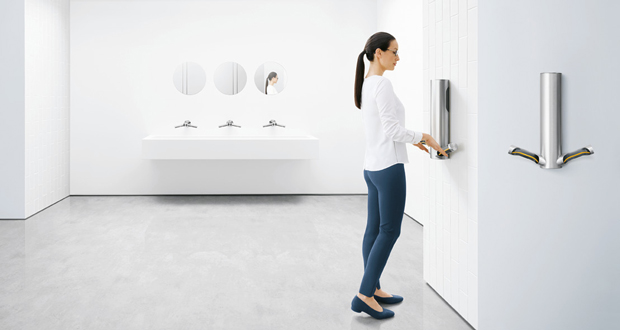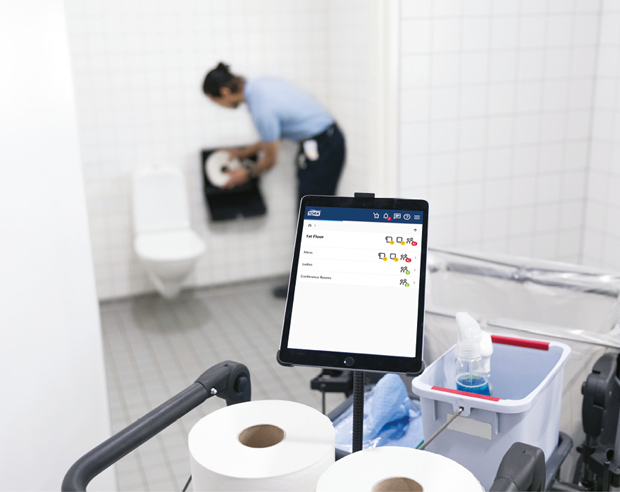SUSTAINABILITY
While it is important to make sure washrooms deliver optimal hygiene they must be provided in as sustainable a way as possible. Dyson’s argument is that sustainability is not just a business goal, but one that translates to consumer values too. “Fortunately, businesses can upgrade their washrooms with more innovative and reusable hand drying solutions, without compromising on hygiene or quality.”
Adds Mulready of Northwood: “As a high user of consumables such as paper towels and toilet rolls, washrooms are under even greater scrutiny when it comes to looking after the environment.
“The need to limit the consumption of disposable products is pressing, particularly as their use in washrooms has never been higher. When selecting dispensing systems for washrooms, providers should therefore try to specify high-capacity, controlled-use devices that restrict the use of toilet tissue and hand towels and prevent over usage.
“It’s important also to make sure that paper products are made only from raw materials that have been sustainably sourced – either from recycled materials or from sustainably managed forests.”
A common alternative to paper towels is hand dryers. Dyson Professional argues its hand dryers include air-cleaning HEPA filters and touchless activation as standard. However, they warn: “Many older warm air dryers prompt hygiene and environmental concerns amongst users, and often rightly so. For example, 40 per cent of people are worried about pressing physical buttons on a hand dryer, and 24 per cent believe they could be drying their hands with unclean air. Alongside this, archaic models could be consuming high amounts of energy, contributing to a business’ carbon footprint.”
FMs should also be careful to assess the sustainability of the washroom supply chain argues Sharp. He recommends you ask, ‘are those businesses environmentally conscious and trying to shrink their carbon footprint; are their logistics as sustainable as can be?’
“It isn’t just about how sustainable the washroom itself is, the bigger picture is just as important. In the washroom, minimising energy and wastage is vital. Battery-free air fresheners, dispensers and taps that run on timers can decrease the energy output of a washroom, without compromising what it delivers.”
ESG CONSIDERATIONS
With ESG becoming an integral part of the FM remit, washrooms also need to be designed to offer an accessible and inclusive environment.
Bowman of KCP explains that while hygiene and safety are top of the list, users also want a pleasant and nurturing environment. “People want to feel cared for and that their needs have been considered. While fear of infection is still prevalent since the pandemic, consumers want to see investment in making facilities better, with well thought out innovations that use the latest technology and design, but are kind to the environment by reducing waste and carbon footprint.”
Sharp advises that facility managers should consider if there are elements in the current washroom that currently don’t accommodate the needs of all users. For example, washrooms need to reflect modern society, so only having baby-changing facilities in female bathrooms, for instance, would be an oversight.
He adds: “Gender-neutral bathrooms have proven successful in smaller facilities for years, often in places where there is only space for one washroom and its accompanying amenities. These can include a single toilet, sink, and mirror, through to baby-changing facilities and disability access support. They cater to everyone’s needs. We are now starting to see this approach adopted in much larger facilities, where accessibility for all is a defining factor of its design.”
It’s also important to install products that are accessible to those users who might struggle with everyday actions such as tearing off a strip of toilet paper or picking up a soap bar and using it to lather their hands.
“All washroom systems should therefore be designed with universal ease-of-use in mind,” says Hands. “In environments such as care homes where manual dexterity may be a problem, toilet tissue dispensers that deliver single sheets will be easier to use than paper on a roll. Foam soaps are quick to lather and easy to use – particularly when supplied in a user-friendly dispenser.”
SUSTAINABLE INNOVATION
The pandemic has helped to revolutionise the way washrooms are managed. Dyson Profession say that their: “past experiences are changing the future of key amenities, and pushing us to implement more innovative, environmentally-friendly solutions throughout. Experiencing high volumes of traffic, the washroom must be made as hygienic and sustainable as possible, both for user confidence and to help businesses lower their carbon footprint.”
Hands advises that the installation of ‘connected’ dispensers will help to ensure that soap and paper supplies need never run out. Sensors incorporated into washroom units allow cleaners to check remotely on supplies of soap, toilet paper and hand towels. This removes the need for staff to make multiple journeys to physically check on dispenser status, saving them time and improving efficiency.
“Tork Vision Cleaning allows cleaners to remotely check on dispensers via a smartphone or tablet. It also incorporates people-counters that enable a facility to build up a profile of washroom visits. The office manager can then use this data to identify those toilets attracting the highest levels of traffic and the cleaner’s walking routes can be streamlined accordingly, again saving time and labour.
“This also includes a digital cleaning plan function to improve cleaning efficiency. Each task is clearly described and given a pictogram to provide cleaners with a quick check-list. They can then tick off each job as it is completed via a smartphone while the manager has instant access to this data so that he or she can tell at a glance whether any stage of the cleaning process has been missed.”
However technological innovations must be designed to help support sustainability initiatives, which is why facility managers must take a macro approach to sustainability says Sharp.
“It’s important to understand the opportunities available when it comes to how manufacturers are innovating to eliminate harmful sourcing of raw materials.
“Reducing the number of virgin fibres used in hygiene products, eliminating plastics from soaps, and purchasing products with 100 per cent recyclable packaging can make the washroom drastically more environmentally friendly. In recent years, we’ve seen the industry strive to create innovative solutions in meeting consumer demand while minimising the damage it has on the planet.”






